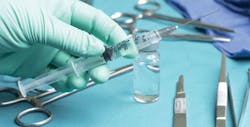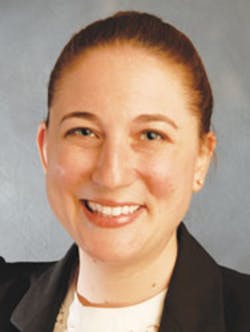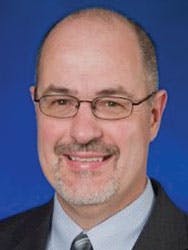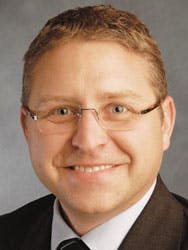Sharps safety calls for aggressive passive design
Ask a clinician what he or she should have to do to perform their patient care tasks safely and the ideal answer likely may surprise you.
Nothing. Or at least next to nothing.
What?
For some, this scenario requires a convergence of attitudes, behaviors and events. These include clinician access to an abundance of safety-engineered, but user-friendly devices that pose limited inconvenience and require little thought to use, coupled with an ability — innate or acquired through education and training — to handle, manage and navigate through the pressure-cooking stresses of providing patient care. The latter also includes anticipating patient reactions to care delivered by sharps devices and distributing exposed sharps devices between clinicians in the surgical field.
“Because of the pressures in the operating room and the prevalence of infectious disease, it is important for clinical staff to have safety-engineered products available to them, and for OR teams to actively participate in the selection of safety devices that will best suit their needs and preferences,” said Mary Hannon, Director of Marketing, Aspen Surgical, Caledonia, MI. “However, safety-engineered products alone will not prevent sharps injury. Safety education, training, personal practices, healthcare facility culture and legislation together with safety-engineered products, have the best chance of decreasing incidence of sharps injury.”
Amber Hogan Mitchell, DrPH, President and Executive Director, International Safety Center (ISC), League City, TX, concurs about the need for a comprehensive solution to preventing sharps injuries that merges safety-engineered product use with safety-minded practices.
“While training and education is a crucial element to any safety program, the hierarchy of controls dictates that first removing a hazard, such as decreasing the need to use needles/sharps where possible, is where focus can shift,” Mitchell told Healthcare Purchasing News. “Researching and developing innovative technologies to deliver medication, vaccines, immunizations and therapeutics means that safer devices are used and by default, healthcare workers are better protected through engineering controls. This allows facilities to focus training and education on better ways to manage adequate staffing, stress management, preventing violence, improving human factors/ergonomics and more.”
A “safety-minded culture,” for example, might prepare clinicians to react more knowledgeably to a patient who flinches during a blood draw or intravenous line hook-up that could force an accidental needlestick or to someone calling out his or her name, diverting attention at the last moment just as he or she deposits a used syringe into the sharps container or hands off a scalpel to another. Such straightforward occurrences may seem familiar to clinicians who experience them during both routine and stressful activities.
Mitchell acknowledges these daily practice challenges. “This is why taking a ‘time out’ to alert others nearby that you are using a sharp item or performing a procedure is important, and is similar to OR pre-surgical time outs, as well as creating engineering controls for the physical environment,” she indicated. One example might be venipuncture chair extensions that promote more stability and comfort and less movement, she added.
As a veteran registered nurse who experienced an accidental needlestick in 1999 and contracted HIV, Karen Daley, PhD, RN, FAAN, Past President, American Nurses Association, fully supports a “safety-minded culture” in healthcare facilities, and has been one of the prominent advocates for the sharps safety cause. Daley had dropped a butterfly needle into a sharps container when she was stuck by a hypodermic syringe jutting out of the top of the container. She, along with Mitchell and June Fisher, M.D., who serves as Director, Training for the Development of Innovative Control Technologies (TDICT) Project since 1990, are active members of the American Nurses Association’s Sharps Injury Prevention Stakeholder Group. TDICT is part of the ISC.
“Injuries are less about the ‘habits or behaviors’ of sharps users than the environment in which healthcare workers practice,” Daley told HPN. “Some of the major environmental factors that contribute to injury incidence are, among others, the pace of the work, rushing, inadequate staffing, fatigue and patient acuity. Due to many of those factors, staff may find themselves distracted, rushed and less than mindful in the moments they are handling sharps. Other underlying issues can relate to inferior or poorly-designed safety-engineered sharps devices, failure of employers to engage direct users in the evaluation and selection of safety-engineered sharps or lack of adequate training for direct users. I also believe we should do everything possible to eliminate use of sharps whenever alternative technology or care options exist, such as administering medications via alternate routes.”
Could process or workflow mapping augment or alleviate the availability of safety-engineered devices?
“I do think environmental engineering — mapping out processes involved in injuries and errors — is one approach with the potential to have a significant impact in preventing these injuries,” she said. “Whether there is a will among healthcare employers to invest in improving workflow is another question. I would like to think it will become more commonplace in the future. Having said that, we know there are safety engineered devices currently available with the potential to further reduce and prevent these injuries. Whether employers are incentivized to spend more money to provide them to their workers is the question. In the absence of any indication that employers are meeting related requirements of the law, enforcement and injury surveillance become critical necessities for protecting healthcare workers.”
TDICT’s Fisher agrees. “We need better scalpels, better devices, better systems altogether,” Fisher said. “Behaviors should not be considered the causes. We just need a systems approach that includes protective devices, better awareness and better cooperation among clinicians – nurses and doctors.”
Working under pressure is common among nurses, Fisher acknowledged. In fact, Fisher thinks their demanding job should drive home a clear message: “We must move away from unprotected devices and more toward protected devices as mandated by the OSHA bloodborne pathogens standard,” she said. “The use of protective devices should be the norm. Unprotected devices should not be easily available even if there are validated uses for an unprotected device.” Fisher added that there may be codified exemptions for a procedure where no protective device is yet available.
“Purchasing plays an important role in this process,” Fisher noted. “They are at the center of this. They should question the ordering of unprotected devices and serve as a key resource to clinicians, end users and other front-line workers.”
Lake Forest, IL-based Stericycle recognizes the intensity of work by nurses, which motivated the company to improve the user-friendliness of its sharps container products.
“Because nurses quickly move from task to task, the need for an easily accessible sharps container is crucial to ensure their safety,” said Alex Napier, Senior Marketing Manager, Healthcare Compliance Solutions. “OSHA requires a contaminated sharp be discarded immediately, or as soon as feasible, into a sharps container. Having an easy-to-use sharps container that requires minimal interaction makes the disposal process significantly smoother and safer.”
OR safety challenged?
The OR consistently records a large number of sharps injuries due to the high volume of sharps devices used, resistance to change and adoption of sharps devices with engineered features, communication challenges, ergonomic issues and that often the surgeon makes decisions about sharps products, according to Mercedes Chavira, RN, Senior Clinical Consultant, Professional Education and Clinical Affairs, Ansell, Iselin, NJ. These factors not only impact the health and safety of clinicians within the surgical field, but also potentially those healthcare workers supporting the clinicians, including those in sterile processing, laundry and housekeeping, she continued.
Chavira further cites research stating that approximately 80 percent of those healthcare workers reporting sharps injuries in the OR weren’t using a safety-engineered device and have been “very slow” in adopting safety-engineered devices, including safety scalpels and handles, and safety-minded practices, such as hands-free techniques and neutral zones for device transfers. In addition, nurses and scrub technicians often suffer injuries when they are passing or disassembling devices, such as sharp retractors and skin hooks, during or after another device disposal. One example is when a nurse or scrub technician returns sharp skin hooks back to surgical instrument trays, she added.
Location and facility type can make a difference, according to Tom Harkin, Global Vice President of Marketing for General Medical Products, Cardinal Health, Dublin, OH. For example, physicians’ offices and dental practices represent somewhat controlled environments where great care can be taken, he indicated.
“In many instances, however, hypodermic needles are utilized in high-stress settings, such as ERs, trauma centers and ambulances,” Harkin noted. “In these environments distractions caused by the need to act with great speed, the physical proximity of co-workers, the emotional atmosphere of critically ill or injured patients, and the pressure on the caregiver to make split-second decisions can result in generally accepted practices not being strictly [followed].”
Nina Morales, Marketing Assistant, Viscot Medical LLC, East Hanover, NJ, posited that safety-engineered products should bolster safety-minded practices, rather than vice versa.
“Even with education and building the behaviors needed to utilize the ‘hands-free technique’ [of passing devices between clinicians] there would still be a need for sharps-safety devices,” she noted. “They can help enforce or enhance the recommended practices, such as specifically designated neutral zones. Sharps-safety devices should seek to improve the already tried and proven recommendations, rather than re-create the wheel.”
Morales cites Centers for Disease Control and Prevention research that stated device hand-to-hand passing is a leading cause for sharps injuries in the OR, motivating the CDC, along with other federal agencies (e.g., OSHA) and professional organizations (e.g., AORN, AST, ACS) to recommend the “hands-free technique” as a viable process improvement. But she admits that the behavioral change hasn’t gone smoothly.
“Many professionals are reluctant to switch to the recommended ‘hands-free technique’ due to a reluctance to change, despite a mountain of evidence on the effectiveness of the technique,” she said. “People get so into a routine that it’s difficult to alter and change. It’s important to be flexible enough to allow these safety advances into your standard practices.”
An understanding that fatigue, stress, time pressures and other factors common to the OR environment, as well as potential staff exposure to HIV, HPC, Ebola and Zika, should drive more routine demand for and production of safety-engineered devices, insisted Hannon, Aspen Surgical.
“We used to see patient safety at the forefront, sometimes at the expense of the healthcare worker,” Hannon acknowledged. “However, many facilities are seeing the importance of staff safety and its close connection with patient safety. If you have a clinical team that feels safe and isn’t distracted by safety incidents, they can put their full focus on the patient and the task at hand. In this way, patient and staff safety are very much intertwined.”
Ansell’s Chavira wonders whether regulatory teeth might change behaviors and processes.
“Training and education plus perhaps financial penalties by regulatory agencies for non-compliance with guidelines could promote wider adoption of engineered sharps safety devices,” she said. Chavira cited a 2011 AORN survey of more than 1,100 perioperative staff nurses and unit directors about sharps safety. Two of five respondents said either their organization didn’t have a sharps injury-prevention education plan or they didn’t know if it did. More than half of survey respondents attributed readily available conventional sharps products and a lack of multidisciplinary support for sharps safety as being two key impediments to complying with sharps safety best practices, according to Chavira.
Daley contends that foundational change is needed.
“I would argue that if safety and just cultures could become the norm in healthcare — focusing as much energy and resources on worker safety as we do on patient safety — that we will have greater success in preventing these injuries,” she said. “It is so important to integrate worker and patient safety efforts in healthcare, and stop laying the blame for these injuries at the feet of the workers themselves instead of improving the environment and systems in which care is provided.”
Can completely eliminating sharps, such as needles and blades, in favor of noninvasive tools, such as lasers, pulsed light or even waterjets, give clinicians access to blood vessels and internal organs without cutting or poking? Daley remains optimistic.
“We already have some examples of non-sharp devices that perform functions like tissue-cutting in the OR,” Daley noted. “Obviously, the ideal would be to reduce and prevent injuries by eliminating sharps wherever possible. I don’t believe a future where sharps will be replaced with other non-sharp technologies is actually that far away.”
Poking through the vacuum
Despite the availability of safety-engineered devices since the 1980s, adoption and use by providers has not kept pace with production, with several sources pointing to demand in the operating room, in particular, as lagging behind supply.
Bob Lawrence, R&D Director, Hill-Rom Surgical Solutions, which includes branded divisions Allen Medical, Aspen Surgical and Trumpf Medical, reasons why.
“Many operating room safety products have been designed with maximum staff protection in mind,” Lawrence said. “But this has sometimes been at the expense of usability, which has most likely prevented wider adoption. For many safety device categories, from syringes and scalpels to neutral zone products, manufacturers have the opportunity to gain more robust clinician input. It is important for manufacturers to consider current workflow, processes and operating room space available in order to achieve both the protection of staff and efficient use of the products. Manufacturers also need to work closely with healthcare facilities to offer cost-effective safety solutions that can fit in tight healthcare budgets.”
Cardinal’s Harkin remains a bit more optimistic, save for the fiscal concerns.
“Safety-engineered hypodermic needles and sharps disposal containers are utilized extensively in most sites of care, and generally serve the purpose for which they are designed when used properly, such as the safety mechanism activated after use and overfilling avoided,” he said. “However, ‘standard’ needles — hypodermic needles with no attached safety mechanism — are still used in many non-acute settings. These products inherently pose a higher level of risk of exposure to caregivers and others who could come in contact with the device post-use. In many instances the decision to use these devices is financially driven, which could prove to be a poor economic — and societal — choice in relation to the costs associated with needlestick injuries.”
Nuts and bolts
TDICT’s Fisher bristles at the term “safe” when describing safety-engineered devices as it may offer a false sense of security for two reasons.
The first reason centers on human behavior and the debate between passive and active safety features.
“Passive safety devices don’t require any effort or thought on the user’s part for the safety mechanism to operate,” Fisher said. “That’s an advantage, and the industry needs to recognize it. Active safety devices require the user to do something to activate the safety feature. We feel the better design for a protective device is a passive design.”
She’s not alone.
Mike Hoftman, President, Advanced Medical Innovations Inc., Northridge, CA, carries the passive torch, too, among others.
“Safety devices must be passive and not active,” Hoftman insisted. “The device has to function in a very simple way without requiring the practitioner to do additional effort to activate the safety feature of the device. Practitioners need to focus on the patient throughout the procedure and not be required to do any unnecessary activities with the devices they are using.” They get fatigued, stressed and tired, and may be handling multiple functions concurrently, he added.
“Device engineers need to make it simple and keep it simple,” Hoftman continued. “It’s very important that they do not complicate the design. Making it passive and not active [means not] requiring an activity to employ the safety feature of the device. The practitioners are very busy and do not have time to deal with this. They have more important equipment they must master during the procedure to worry about how a safety device functions.”
Fisher’s second reason centers on the design process itself – specifically who’s involved. Fisher feels it’s important that devices with passive protective features be co-designed with practitioners and other end users. Front-line worker involvement is critical, she urged. Much of her research focused on recruiting clinicians from a variety of hospitals to chart workflow and contribute guidelines for device design. She co-taught product design classes at Stanford University and at University of California-Berkeley, and now co-teaches at San Francisco State University. From TDICT’s post at San Francisco General Medical Center, her group developed specific criteria for end users to evaluate products for safer use, leading to the emergence of “safer” protective devices. She said she came up with a motto: “Don’t design for us; design with us.” She quipped that co-designing even could represent a career path option for clinicians.
Based on the opinions of people she meets on her lecture and presentation circuit, Fisher expresses concern about industry momentum and progress toward front-line healthcare workers evaluating and selecting devices using specific criteria on what they need to be protected as mandated by the law. “I’m not confident that this is being fully implemented by clinicians and other front-line workers,” she said. “When I talk to people I see that it’s not happening in many areas.” She worries that many healthcare organizations still need to understand what the Congressional needlestick safety and prevention legislation and OSHA bloodborne pathogen standard say and mean and how to comply with them.
For Fisher the bottom line is that front-line end users should be involved in co-designing and developing protective devices, training through design courses, and identifying needs for new designs based on clinical task analysis. They also should be using validated, systematic methods and tools (like those of ISC’s TDICT Project) to evaluate and select protective devices, she added.
Editor’s Note: For more information on ISC, TDICT and the ANA’s Sharps Injury Prevention site, click here: www.internationalsafetycenter.org, www.tdict.org and www.nursingworld.org/practice-policy/work-environment/health-safety/safe-needles/. Visit earlier editions of HPN for past coverage, including “Sharps safety: Should healthcare workers get passive aggressive?” March 2004, www.hpnonline.com/inside/2004-03/Sharps%20Safety.htm and “Reinforcing needlestick prevention through a culture of safety,” October 2008, www.hpnonline.com/inside/2007-10/0710-ssg.html.
Sidebars:
- Understanding the point of sharps safety momentum through the years
- A sharper image of safety-engineered products
About the Author
Rick Dana Barlow
Senior Editor
Rick Dana Barlow is Senior Editor for Healthcare Purchasing News, an Endeavor Business Media publication. He can be reached at [email protected].









